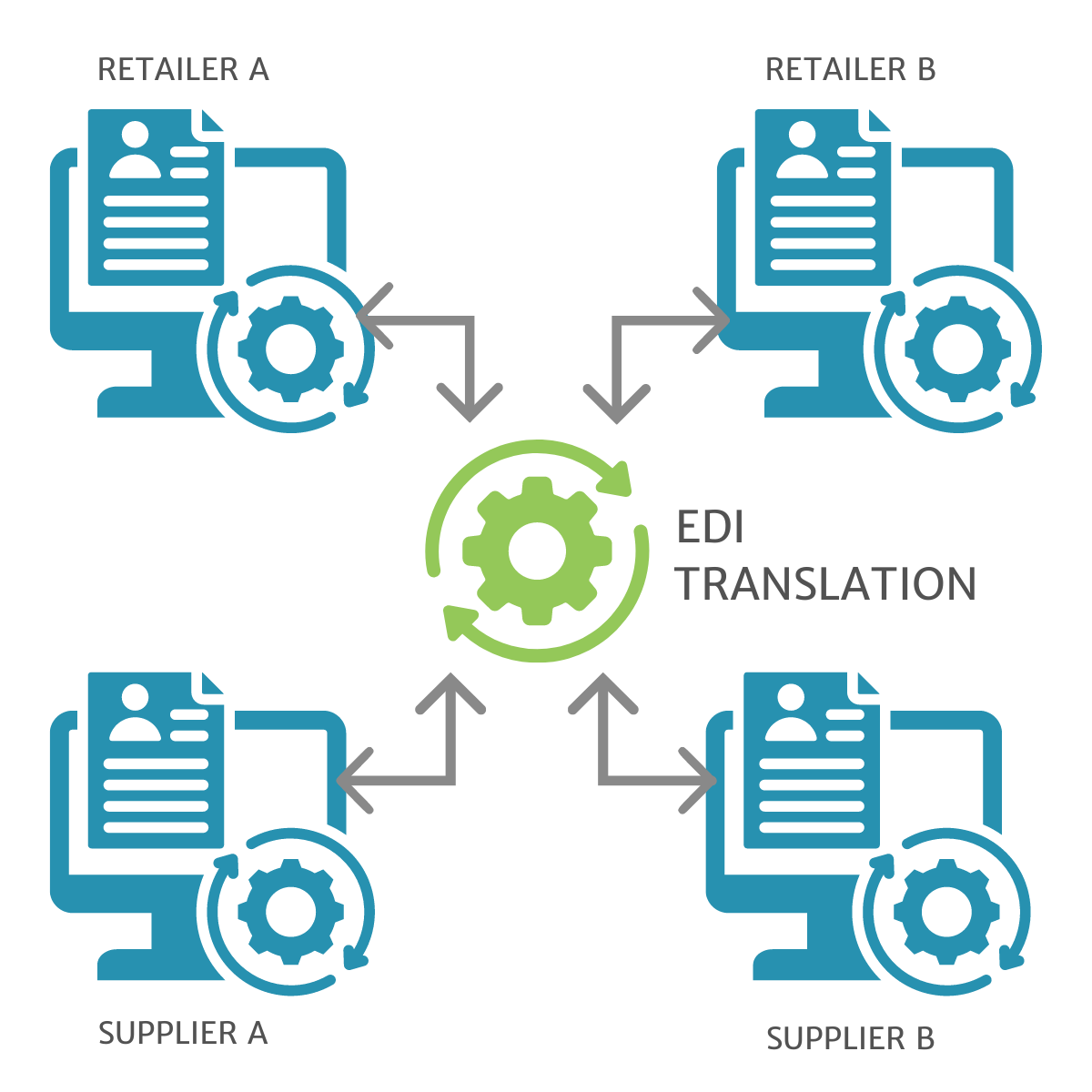Introduction to EDI Automation
In today’s fast-paced business environment, efficiency is key to maintaining a competitive edge. One area where organizations can significantly improve efficiency is by leveraging EDI automation in the reconciliation process between purchase orders and invoices. By leveraging EDI technology, businesses can automate this labor-intensive task, saving time, reducing errors, and streamlining their operations. For both suppliers and retailers, can significantly accelerate business processes, leading to streamlined operations, improved cash flow, and enhanced retailer and supplier relationships.
What is EDI?
Electronic Data Interchange (EDI) is a technology that facilitates the exchange of structured data electronically between trading partners. Instead of relying on paper-based documents, such as purchase orders and invoices, EDI enables the seamless transfer of data from one computer system to another in a standardized format.
The primary advantage of using EDI for data exchange is the elimination of manual processes and the associated errors. By electronically transmitting data in a structured format, businesses can automate the processing and reconciliation of purchase orders and invoices, leading to increased efficiency and reduced costs.
EDI relies on standardized formats and protocols to ensure compatibility and seamless integration between different systems. Common EDI standards include ANSI X12 and EDIFACT, which define the structure and content of electronic documents. EDI communication protocols, such as AS2 (Applicability Statement 2) and sFTP (Secure File Transfer Protocol), facilitate secure and reliable data transmission over networks.
Understanding Purchase Order to Invoice Reconciliation
Reconciling purchase orders with invoices is a critical process in business operations. It involves comparing the details of a purchase order, which outlines the items or services ordered, with the corresponding invoice received from the supplier. The goal is to ensure that the goods or services provided match what was initially agreed upon and that the pricing and quantities are accurate.
Manual reconciliation processes can be time-consuming and prone to errors. They often involve manually matching line items, comparing quantities and prices, and investigating discrepancies. These manual tasks can be a drain on resources and can lead to delays in payment processing, inaccurate financial records, and strained supplier relationships.
By automating the purchase order to invoice reconciliation process using EDI, businesses can streamline operations and overcome the challenges associated with manual data entry methods.
Step-by-Step Process: How to Automate Purchase Order to Invoice Reconciliation with EDI

Step 1: Setting up an EDI system
Implementing an EDI system requires selecting an appropriate EDI solution provider that aligns with the organization’s needs. The provider will assist in integrating EDI capabilities with existing systems, such as enterprise resource planning (ERP) or accounting software, to ensure seamless data exchange.
Step 2: Mapping purchase order and invoice data
Mapping refers to defining the relationship between the data elements in the purchase order and invoice documents. This step involves understanding the structure and format of both documents and establishing mapping rules for data transformation. Mapping rules ensure that the relevant information is extracted and accurately transferred between systems during the reconciliation process.
Step 3: Implementing EDI transactions
Once the mapping is established, businesses can generate and transmit purchase orders electronically to suppliers using EDI transactions. Purchase orders can be created in the organization’s system and transformed into the appropriate EDI format before transmission. On the supplier’s end, the EDI system receives the electronic purchase order and integrates it into its system for processing.
Similarly, electronic invoices can be sent by suppliers using EDI transactions, which are received and processed by the organization’s EDI system. Electronic invoices eliminate the need for manual data entry, as the relevant information is automatically extracted and integrated into the accounts payable system.
Step 4: Validating and reconciling data
Automated data validation is a crucial aspect of the EDI process. The EDI system performs validation checks on the received purchase orders and invoices to ensure data integrity and adherence to predefined rules. This step helps identify any errors or discrepancies early in the process, minimizing manual intervention and streamlining the reconciliation workflow.
The reconciliation process involves matching the purchase orders with the corresponding invoices based on key identifiers such as order numbers, item codes, or supplier names. The EDI system compares the data elements, quantities, and pricing to ensure they align. Any discrepancies are flagged for further investigation and resolution.
Step 5: Exception handling and dispute resolution
Despite the efficiency of automated processes, exceptions and disputes may still arise. EDI systems provide mechanisms to handle exceptions effectively. Discrepancies in quantities, pricing, or delivery dates can be identified and flagged for resolution. The process involves communication with the supplier to rectify the issues and reach a mutually agreed-upon resolution.
Organizations can establish clear escalation paths and communication channels to ensure prompt and efficient resolution of disputes. Effective exception handling and dispute resolution processes contribute to maintaining strong supplier relationships and minimizing disruptions in the purchase order to invoice reconciliation workflow.

Real-World Example: Supplier-Retailer Collaboration
Let’s consider a real-world example of how automated PO match using EDI benefits a supplier and a retailer:
Supplier A is a clothing manufacturer that supplies products to Retailer B, a large chain of department stores. In the traditional manual process, Supplier A would send paper invoices to Retailer B, which required manual data entry and matching against purchase orders. This process was time-consuming, prone to errors, and often led to payment delays.
To streamline their operations, Supplier A and Retailer B implemented an automated PO match using EDI. Supplier A integrated its invoicing system with Retailer B’s EDI platform, allowing seamless electronic transmission of invoices. Retailer B’s system automatically matched the invoices against the corresponding purchase orders, verifying quantities, prices, and product details.
The automation resulted in significant time savings for both parties. Supplier A no longer had to spend hours manually preparing invoices and could rely on the accuracy of the automated matching process. Retailer B benefited from faster invoice validation and reduced payment delays, enhancing their supplier relationships.
Benefits for Retailers and Suppliers - After Implementing EDI Automation for the Purchase Order to Invoice Reconciliation Process
Benefits for Suppliers
Faster Invoice Processing
Suppliers can submit electronic invoices directly through the EDI system, which eliminates the need for paper-based invoicing and manual data entry. The invoices are automatically matched against the corresponding POs, accelerating the overall invoice processing time.
Reduced Payment Delays
By automating the PO match, suppliers can ensure that their invoices align with the agreed-upon terms and conditions. This reduces the likelihood of payment delays caused by discrepancies or errors, leading to improved cash flow for the supplier.
Improved Accuracy
Manual data entry is prone to errors, which can cause delays and payment disputes. With automated PO match using EDI, suppliers can achieve greater accuracy in their invoicing, minimizing errors and avoiding unnecessary back-and-forth communication with retailers.
Benefits for Retailers
Efficient Invoice Validation
With automated PO match, retailers can quickly validate incoming invoices against the corresponding purchase orders. The system automatically compares quantities, prices, and other relevant details, flagging any discrepancies for review. This streamlines the validation process and ensures accurate payment processing.
Enhanced Speed and Efficiency
Automating the PO match eliminates the need for manual data entry and reduces the time spent on manual reconciliation tasks. Retailers can process invoices more efficiently, enabling faster payment cycles and improving overall operational efficiency.
Strengthened Supplier Relationships
Prompt and accurate payment processing improves supplier relationships by instilling confidence and trust. Retailers that consistently meet payment obligations through streamlined processes are more likely to attract and retain reliable suppliers, fostering long-term partnerships.
Conclusion
Automating the purchase order to invoice reconciliation process using EDI automation brings numerous benefits to businesses, enabling them to streamline their operations, reduce costs, and improve efficiency. By implementing the steps outlined in this blog post, organizations can eliminate the time-consuming and error-prone manual reconciliation process, and instead, leverage the power of EDI to achieve faster, more accurate results.
Affordable and Rated #1 EDI Solutions Provider in North America
For over 35 years, Commport Communications has been providing the most affordable and best EDI solutions in the market. By helping companies solve complex integration issues and providing complete EDI communication between business partners.
Commport EDI integration experts can manage all the EDI and B2B integration processes for you, with the flexibility and scale that you truly need. Regardless of how you move your EDI files, Commport will always make sure that you have full access to all your data in real-time, including web-based dashboards, transaction reports, and automated alerts.
Improve your business process and maximize your supply chain performance with our EDI solutions. Contact us today for a free consultation and demo.
Ready to find out more about Commport EDI Translation and Mapping Services?
Download: EDI Buyers Guide
Unlock the full potential of your supply chain with our comprehensive EDI Buyer's Guide — your first step towards seamless, efficient, and error-free transactions
Frequently Asked Questions
The cost of implementing an EDI system can vary depending on factors such as the size of your business, the complexity of your requirements, and the solution provider you choose. It’s best to consult with EDI service providers to get an accurate estimate based on your specific needs.
Yes, EDI systems can be integrated with various enterprise resource planning (ERP) and accounting systems. Most EDI service providers offer integration options and support for popular software platforms. It’s important to discuss your integration requirements with the EDI provider during the selection process.
Yes, EDI systems employ robust security measures to ensure the confidentiality, integrity, and availability of data. Encryption, authentication, and secure transmission protocols are commonly used to protect sensitive information during exchange.
The implementation timeline can vary based on factors such as the complexity of your requirements, the readiness of your systems for integration, and the cooperation of the stakeholders involved. On average, an EDI implementation can take several weeks to a few months.
Automated EDI systems provide mechanisms for identifying and resolving discrepancies. When discrepancies occur, they can be flagged for further investigation and resolution. Robust exception-handling processes and effective communication with suppliers are crucial in resolving disputes promptly.





